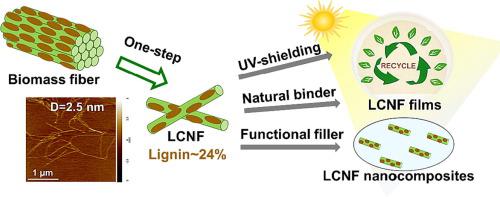Chemical Engineering Journal ( IF 13.3 ) Pub Date : 2023-08-05 , DOI: 10.1016/j.cej.2023.145189 Kexia Jin , Da Zhang , Binqiang Pan , Khak Ho Lim , Tiffany Abitbol , Wen-Jun Wang , Xuan Yang

|
With nano-dimension, high aspect ratio, and high mechanical properties, cellulose nanofibrils (CNFs) are emerging sustainable nanomaterials with potential applications in films and composites. However, their preparation often involves a series of chemical treatments such as delignification, bleaching and harsh chemical pretreatments, and treats lignin as waste. Herein, we report a sustainable method to prepare high-quality lignin-containing cellulose nanofibrils (LCNFs) from bamboo chips, using a one-step maleic anhydride esterification treatment without any toxic organic solvent or catalyst. The resultant LCNFs have high lignin content (24%), high surface charge (2.25 mmol/g), fine diameter (∼2.5 nm), and high aspect ratio (>400). These superior properties can be translated into the corresponding nanopaper films with high optical transmittance (85% at 600 nm), UV shielding (<10% transmittance at 200–350 nm), hydrophobicity (water contact angle 75°), thermal stability (maximal weight loss temperature at 338 °C), and mechanical properties. Importantly, such films show the best reported tensile strength (290 MPa) among all the LCNF films, and it still outperforms conventional CNF films after 5 rounds of recycling. Furthermore, as sustainable nanofillers, such LCNFs can be directly incorporated into a hydrophobic polyester matrix, and significantly enhances the UV shielding and mechanical properties of the final nanocomposites. Altogether, with eco-friendly production and multiple functions, these LCNFs are a new class of nanocelluloses with high industrial relevance.
中文翻译:

制备功能性含木质素纤维素纳米纤丝的可持续途径
纤维素纳米原纤维(CNF)具有纳米尺寸、高长径比和高机械性能,是新兴的可持续纳米材料,在薄膜和复合材料中具有潜在的应用前景。然而,它们的制备通常涉及一系列化学处理,例如脱木质素、漂白和苛刻的化学预处理,并将木质素作为废物处理。在此,我们报告了一种从竹片制备高质量含木质素纤维素纳米纤维(LCNF)的可持续方法,采用一步马来酸酐酯化处理,无需任何有毒有机溶剂或催化剂。所得的 LCNF 具有高木质素含量 (24%)、高表面电荷 (2.25 mmol/g)、细直径 (∼2.5 nm) 和高长径比 (>400)。这些优异的性能可以转化为相应的纳米纸薄膜,具有高光学透过率(600 nm 处为 85%)、紫外线屏蔽(200–350 nm 处<10% 透过率)、疏水性(水接触角 75°)、热稳定性(最大失重温度(338°C)和机械性能。重要的是,这种薄膜在所有 LCNF 薄膜中表现出最好的拉伸强度(290 MPa),并且在 5 轮回收后仍然优于传统的 CNF 薄膜。此外,作为可持续的纳米填料,此类LCNF可以直接掺入疏水性聚酯基体中,并显着增强最终纳米复合材料的紫外线屏蔽和机械性能。总而言之,这些 LCNF 具有环保生产和多功能的特点,是一种具有高度工业相关性的新型纳米纤维素。













































 京公网安备 11010802027423号
京公网安备 11010802027423号